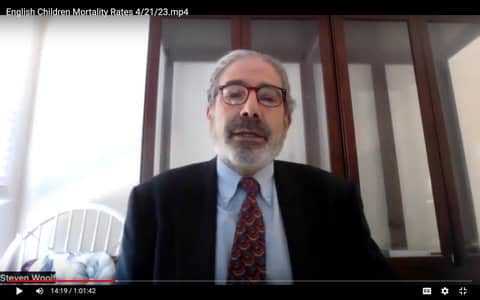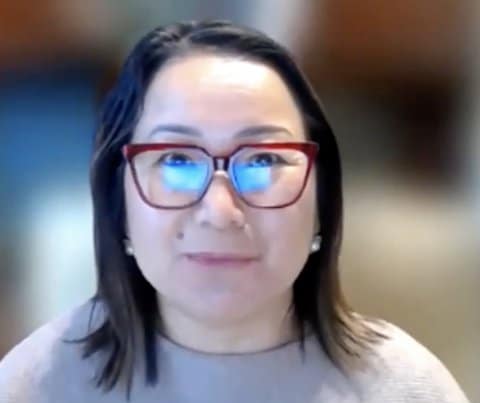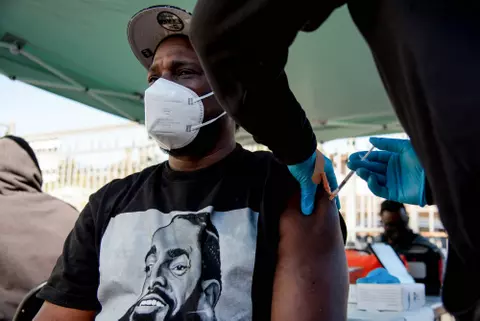
19 May Children Are Dying at Increasing Rates

“The probability of young people reaching age 20 is now decreasing,” said Dr. Steven Woolf during an April 21 press briefing. (Screenshot captured by Danielle Parenteau-Decker / The CC Pulse)
By Danielle Parenteau-Decker
For the first time in a long time, children’s chances of making it to adulthood are going down.
Advancements in medicine and safety had been consistently bringing child mortality rates down for decades. But in recent years, those rates have started to climb, driven by four leading causes, authorities say: homicide, suicide, accidental drug overdose and car accidents.
Ethnic Media Services asked a doctor and public health expert, a social researcher, a children’s advocate and an attorney for a leading anti-gun violence organization to examine what is going in an April 21 national press teleconference that asked, “Why Are More U.S. Kids Dying?”
“This is very unusual. It’s not occurred very much at all over the last half century,” said Dr. Steven H. Woolf, referring to the increase in child mortality in 2020 and 2021. He said the mortality rates are “of a magnitude that we have not seen probably since the influenza pandemic of 1918.”
“The probability of young people reaching age 20 is now decreasing,” he said.
Decreases in child mortality are “usually the good news in what has otherwise been a dismal picture in terms of the health of Americans,” said Woolf, a professor of family medicine and population health at Virginia Commonwealth University.
“We really have reached a tipping point where these deaths are so high that it’s offsetting many, many, many of the incredible gains our country — our world — has made in treating pediatric diseases,” said Mayra Alvarez, president of the Children’s Partnership. “Our children are dying from preventable causes. These are man-made reasons why our children are dying, not biological.”
While the drop in youth life expectancy has roughly coincided with the pandemic, COVID-19 was not among the primary causes of the increased deaths, though it can present real risks to children.
“The COVID-19 pandemic … didn’t cause this trend,” Woolf said. “But it poured fuel on the fire. The rates increased dramatically in this time period.”
Some of the increases came before the pandemic.
According to Woolf, “suicide rates began increasing in 2007” and homicide rates, in 2013 among people aged 1-19. “The increase in drug overdose deaths began shortly before the COVID-19 pandemic.”
The risk of dying from any of these causes is not borne out equally among all young people.
“I think it’s important to talk about the racial and ethnic differences,” Woolf said. “Young people were not equally affected by these trends.”
“Black youth were at considerably greater risk of dying from homicides than any other racial or ethnic group, he said.” Additionally, the auto-accident death rate is highest among American Indian/Alaska Native youth; the suicide rate, among Black and American Indian youth.
“Black children are far more likely than white, Hispanic and Asian children to die from gun-related injury,” said Kim Parker, director of social trends at Pew Research Center.
While gun violence is not among those leading causes, it is still a significant factor.
“Guns are an important protagonist in a young person’s risk of dying,” said EMS’ Pilar Marrero, who moderated the discussion.
Woolf agreed. “Firearms played a dominant role in this increase.”
While school shootings, other mass shootings, and other forms of gun violence have become frequent occurrences, legislative efforts to slow them have struggled to gain traction.
“I am old enough to have watched this problem unfold over many decades and after Sandy Hook really became very pessimistic that we can achieve change because … if that’s not enough … what is?” Woolf said.
But he hasn’t completely lost hope.
“I’m hopeful that the next generation and the increasing attention … might motivate politicians to pass common sense gun control measures,” he said.
Kelly Sampson is senior counsel and director of racial justice for Brady: United Against Gun Violence, which she called “one of the nation’s oldest gun violence prevention groups.”
She said one of the reasons why gun control legislation fails is the idea that if someone wants a gun, they’ll find a way to get one, no matter what the law says.
Sampson said the problem with that attitude is that it focuses on gun buyers. Laws focused on the industry, on the other hand, “would go a long way toward preventing gun violence and the trauma that it causes.”
Woolf spoke about the increase in gun sales during the pandemic, saying it was people “buying more guns than they already had to quote-unquote protect themselves from perceived threats that, I think, have been generated a lot by advertising and marketing by gun manufacturers and the NRA. But is not actually a real threat.”
Conversely, while people might say they’re getting guns for protection, they are often actually putting their loved ones at risk.
“In general, if a child is going to die — if anyone in the family is going to die of a gun-related death, it’s more likely to occur because of the gun that is already inside the house,” he said.
Woolf and Sampson also pushed back on the tendency to blame deadly violence on gangs and video games.
He said that homicide deaths were mostly related to domestic violence and some other forms of conflict and that there were “racist undertones” to blaming gangs.
“People who are not affected and not members of low-income communities or communities of color can shake off responsibility for dealing with the problem,” Woolf said.
Sampson said that while there is a lot of talk about a supposed link between video games and aggression, there is “not really a strong relationship there at all.”
“The video game industry is global, but the difference is that in the United States, there’s this access to firearms,” she said.
As Alvarez of the Children’s Partnership said, “It’s about the guns. It’s always about the guns.”
In considering what should be done to help children actually survive into adulthood, Woolf said there were two areas, in particular, that policymakers should prioritize.
“One is the need to deal with firearms,” he said. “No. 2, the mental health crisis in young people.”
>>>Read: Kids Continue to Suffer in Mental Health ‘Shadow Pandemic’
Parker said Pew surveyed a very large sample of parents nationwide last fall. Some of the questions asked them about the challenges their kids face and the parents’ worries.
“The top concern for parents by far was mental health,” she said.
Alvarez said there needs to be more mental health services for youth that are community-oriented and include peer-to-peer support, which is something she said young people have said they want more of.






No Comments